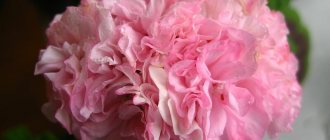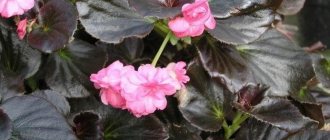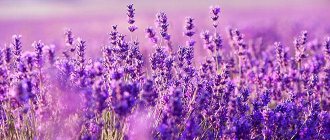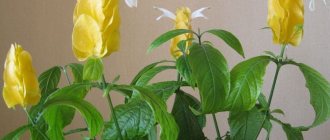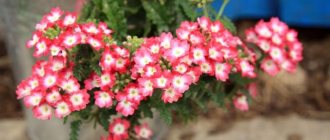Author: Elena N. https://floristics.info/ru/index.php?option=com_contact&view=contact&id=19 Category: Garden plants Published: February 27, 2019Last edits: January 20, 2021
- When to plant
- Growing conditions
- How and when to collect seeds
- Bluebell annual
flowers (lat. Campanula) belong to the genus of herbaceous plants of the Campanula family, which includes more than three hundred species growing in places with a temperate climate - in the Caucasus, Western and Central Asia, Europe, Siberia, and also in North America. Bells prefer steppes, meadows, forests, desert areas and rocks. Many species of these flowers grow in alpine and subalpine mountain belts. The Latin name is translated as bell. People call these flowers chenilles, chebotkas and bells.
Planting and caring for bells
- Planting: sowing seeds in open ground - in October or May. Sowing seeds for seedlings - in March, planting seedlings in open ground - at the end of May or at the beginning of June.
- Flowering: at different times - depending on the type and variety.
- Lighting: usually bright sunlight. There are only a few shade-loving species in the genus.
- Soil: any soil, even rocky and calcareous, but best drained loam with a neutral or slightly alkaline reaction.
- Watering: moderate and only in dry seasons.
- Staking: Tall varieties require support.
- Top dressing: on melted snow - with nitrogen fertilizer, during the budding period - with a complete mineral complex.
- Reproduction: annuals - only by seeds, biennials - by seeds and spring cuttings. Perennials can be propagated by parts of the rhizome, root cuttings, stolons, or dividing the bush, but when propagated by seed they do not retain varietal characteristics.
- Pests: slobbering pennies, slugs.
- Diseases: fusarium, botrytis, sclerotinia.
Read more about growing bells below.
Interesting Facts
- There is an old legend that the plant brings a lot of good luck to the home, and in some countries the flower is considered sacred. Such countries include England, where growing these flowers in homes is a sign of the well-being and longevity of the owners.
- The name of the culture is not without reason: previously the sprouts looked like those bells that most wandering monks wore on their chests.
- The great Russian writer Alexei Nikolaevich Tolstoy wrote a wonderful work about this flower, which is called “My bells, steppe flowers!”
Growing bells from seeds
How to sow seeds
Bluebell seeds do not require preliminary preparation before sowing. They can be sown directly into the ground in May or before winter in October. But if you want them to bloom this year, sow them as seedlings in March.
Since the seeds are very small, they are laid out on the surface of a light, loose, permeable substrate, previously well moistened and consisting of humus, turf soil and coarse sand in a ratio of 3:6:1. There is no need to add fertilizer to the substrate. The seeds are lightly pressed to the ground, sprayed with water from a spray bottle, and then the container is covered with film. Contain crops at a temperature of 18-20 ºC. Shoots may appear in two to three weeks.
- Professional advice on caring for wisteria (video)
Seedling care
As soon as the seeds begin to germinate, move the container to a bright place, protected from direct sunlight, remove the film and care for the bell seedlings as you would any other flower seedlings: water when the top layer of the substrate dries, loosen the soil around the seedlings, and when they turn three weeks and their first leaves will develop, the seedlings dive into a large container at a distance of 10 cm from each other. Two weeks after picking, feed the seedlings with liquid complex fertilizer in low concentration
Useful properties of the plant
Bellflower is not very well known to people for its beneficial properties, but they have a very wide range of uses:
- the plant has antitussive and soothing qualities;
- used as an antirheumatic agent;
- the decoction treats epilepsy in children;
- infusions are used for sore throat, stomatitis, and colds;
- used in the treatment of glaucoma, atherosclerosis, fever, sexually transmitted diseases;
- used to treat skin lesions, erysipelas, lichen;
- used as a wound healing agent for dog and mosquito bites;
- treats hypertension, migraines, cardiovascular system;
- used as an antispasmodic agent for diseases of the gastrointestinal tract;
- helps with gynecological ailments, PMS;
- treats diseases of the central and peripheral nervous system.
Planting bells in open ground
When to plant
Bluebell seedlings are planted in open ground at the end of May or beginning of June. Most of the bells are light-loving, shade-loving species grown in cultivation are literally only a few, and they can be recognized by the dark green color of the leaves. The bell does not like drafts.
As for the soil, some species grow well on rocky soil, some on calcareous soil, but most species prefer neutral or slightly alkaline well-drained loamy soils. Planting bells in the soil is carried out after its preliminary preparation: for deep digging, sand and humus are added to heavy soils, and turf soil and fertilizers are added to poor soils. Do not apply only fresh manure and peat, as this increases the risk of fungal diseases affecting the plants.
How to plant
Bells are planted in open places, away from bushes and trees, so that their roots can receive the necessary amount of moisture and nutrition. Low-growing bells are planted at a distance of 10-15 cm from each other, medium-height bells at a distance of 20-30 cm, and tall ones at an interval of 40-50 cm. After planting, the soil around the flowers is trampled down and watered well.
short
- Carpathian bellflower (C. carpatica) up to 30 cm tall, forms curtains up to 30 cm in diameter. Flowers are on thin stems, single, large, blue or white. In culture since the end of the 18th century.
- Bellflower, or spiral-leaved , (C. cochleariifolia) no more than 15 cm tall. Inflorescences are few-flowered. The flowers are small, drooping, blue or white, there are double forms.
Campanula spiralifolia
Caring for bluebells in the garden
Growing conditions
Growing bells is no different from growing any other garden flowers - bells are unpretentious. Water them only when prolonged heat and dryness sets in. After watering, it is convenient to loosen the soil around the flowers and remove weeds. Tall bells are tied to a support as necessary. The bells are fed for the first time in the spring, on melted snow, with nitrogen fertilizer. The second fertilizing with complex fertilizer is carried out in the first half of summer, at the beginning of budding. To prolong the flowering of bluebells, promptly remove faded flowers.
Reproduction of bluebells
Annual bells are propagated by seeds, biennials by seeds and spring cuttings. Perennial bells can be propagated by root cuttings, parts of rhizomes, dividing the bush and stolons, since when propagated by seed they do not always retain varietal characteristics. Terry varieties of bells do not set seeds, so they are propagated exclusively by vegetative methods.
Perennial species of bells with a carpal or taproot system are considered vegetatively immobile and reproduce by seeds. Those species that have a short rhizome are considered vegetatively inactive - they are propagated by division and cuttings. Species with long creeping rhizomes, which reproduce both by seeds, division and cuttings, and by rhizome segments and root suckers, are considered vegetatively mobile.
We described the seedling method of propagation to you, but you can sow the seeds in mid-October directly into the ground, where they will undergo natural stratification during the winter months and sprout together in the spring, and all you have to do is plant the seedlings. You can sow seeds in the ground in May, but then they need to be stratified for two months in the vegetable drawer of the refrigerator, and since annual bells reproduce well by self-sowing, is it worth complicating your life by stratifying the seeds?
Cuttings of bells are harvested in the spring, in March-April - they are cut from young stem or root shoots, planted in a light, loose substrate and placed under a film dome to create high air humidity. It is best to use a greenhouse and a special fog sprayer for this purpose. Root regrowth of cuttings occurs within three to four weeks.
The division of the bush is carried out in the third to fifth year of the plant’s life, but some species can be divided already in the second year. At the beginning of May or at the end of summer, large bushes are dug up and, having cut the stems, divided into parts with a sharp sterile knife, each of which should have developed roots and renewal buds, after which the sections are treated with crushed coal and the sections are immediately planted in a permanent place.
When propagating by parts of the rhizome, the creeping root of the plant is dug up, divided into parts so that each segment contains renewal buds, and planted in the ground so that the buds are at the level of the soil surface.
Root suckers need to be separated from the mother plant and immediately planted in a permanent place.
Pests and diseases
Blooming bells look very cute, but this is not the only advantage of flowers. They are so unpretentious that planting and caring for a bell is a pleasure and does not require time or effort.
- Features of growing hybrid tea roses
Bells are immune to diseases and pests and are very rarely affected by them, however, when flowers are grown for many years in one place, pathogenic microorganisms - Fusarium, Sclerotinia or Botrytis - accumulate in the soil, which can lead to the death of the plant. To prevent this from happening, treat the bells with a 0.2% solution of Fundazol twice a season, in spring and autumn.
In humid weather, slobbering pennies may appear on the bells, which are expelled with garlic infusion. Low-growing bells can be damaged by slugs, from which the plants are sprayed with a decoction of hot pepper and superphosphate granules are scattered under the flowers.
Annual flowers that are not afraid of heat
And this information will be of interest to my fellow countrymen, residents of Kuban. The summer of 2022 was very hot for us. Other regions complained about the cold summer, but for us it was the opposite. And in my flower beds, in the flower beds of my friends, there was no particular splendor. Some flowers refused to bloom, others had sparse flowers, and others simply survived in extreme heat - it was a pity to look at them.
But there were flowers that were not affected by either the abnormally hot sun or the rare but torrential (in the full sense of the word) rains. But before, I even weeded them out. These were annuals, but they sprouted by self-sowing and did not grow where I needed them. That is, that summer showed that these flowers are very resilient. In the conditions of that summer, they were the only ones that bloomed and smelled profusely.
These are mirabilis, aromatic tobacco and purslane. I will write briefly about each.
Mirabilis
This flower always grew in the flower garden of my grandmother and mother, and I also love it very much. True, as a child I did not know his real name; we all called him Zorka. And it fully lived up to its name. The flowers opened in the evening, stood open all night and only closed in the morning at dawn. We had varieties with bright crimson flowers, but there are also ones with white, yellow, pink and soft salmon petals. I’ve even seen it with flowers of different colors on the same bush. In its homeland it is a perennial; in the conditions of Kuban it may or may not survive the winter, but then in the spring shoots appear in this place, of which only the strongest and healthiest remain. I think that in the conditions of the middle zone this is definitely an annual. By the way, many people grow it at home on the windowsill.
Mirabilis is an unpretentious plant. Apart from evening watering, light loosening, and removing weeds, last year he received nothing from me, but he was almost the main decoration of the garden. Bloomed until the coldest weather. And they arrived almost in December.
Fragrant tobacco
For me, fragrant tobacco is a flower that I “planted and forgot.” It is an annual plant, but every year in the spring new shoots appear in the same place. I just have to stop it from growing all over the garden. But to be honest, I don't try too hard. The flowers of fragrant tobacco are not very noticeable, but in the evenings such an aroma spreads throughout the garden that you don’t want to get rid of the “extra” plants. It also does not require special care. Only seedlings can be “clogged” by weeds, so their removal is necessary at first. Then, when the plant gets stronger, no weeds are afraid of it. Only the fittest and strongest survive the winter. Sometimes in the spring I replant tobacco plants from places where I don’t need it to empty spaces in the flowerbed. As it grows and becomes a fluffy bush, it not only covers a bare spot in the flower garden, but also creates a background for low-growing plants.
Purslane
Purslane is also a flower from my childhood. Every summer I saw him in both my grandmother’s and mother’s flower gardens. We called it “the carpet” because it covered the ground with a bright carpet along the paths in the front garden. It was the purslane that gave the flower garden a certain completeness. What beautiful purslane flowers! There are simple ones, there are double or semi-double ones in a wide variety of colors. Purslane blooms all summer, from June until frost. In the evenings the flowers close, but in the morning they “burn” like multi-colored lights in a flower bed. You can sow purslane only once and, thanks to its abundant self-sowing, it will delight you every year. Loves sunny places, blooms poorly or not at all in the shade. Grows well in sandy soils. But he also likes my black soil. I don’t know how true my observations are, but it seems it’s better not to fertilize purslane. By growing, purslane can even survive weeds. I have never observed weeds in the place where it grows.
When choosing annual flowers for your garden, you can buy seedlings or seeds in flower shops or supermarket departments. Today, the choice of seeding materials is so wide that finding the desired flower is not difficult.
Tall representatives are great for decorating flower beds or mixed borders; in mixed flower beds they usually create the background. When planning the design of the site for the summer season, take into account the combination of sizes (heights) of plants and their color scheme. Flower requirements for soil moisture, lighting, and fertilizers should also be kept in mind. Sometimes plant species with the same name can be both tall and short, medium-sized. When purchasing seeds, read the attached information. Annual flowers that bloom all summer - the name and photo are always on the packaging. Try to ensure that crops that grow next to each other are close from an agrotechnical point of view.
Perennial bells after flowering
How and when to collect seeds
If you want to get seeds of your favorite species, then do not wait for the boxes to open; cut off the inflorescences left for the seeds in advance, as soon as the boxes acquire a brown tint, and ripen them in a ventilated, dry room.
Preparing for winter
Planting and caring for perennial bluebells is no different from growing annual or biennial varieties, except that they need to be prepared for winter. At the end of September or beginning of October, the stems of all bells are cut off at the root. This completes the care of annual flowers. As for biennial and perennial species, many of them overwinter without shelter, but southern species need to be covered with dry leaves or covered with spruce branches. Tall bells are covered with a layer of humus or dry peat 15-20 cm high. This will be enough for perennial bells to survive the winter.
Blooming annual vines
If you put climbing annuals on the fence, you will get an excellent hedge. Photos and names of the most popular climbing annual plants:
- Kobeya. From the beginning of July until the end of the summer season, large flowers bloom in white, yellow, blue, and purple shades;
- Kvamoklit has delicate greenery and bright red flowers of medium size. An excellent option for a hedge;
- Farbitis (Ipomoea). The wealth of colors covers almost the entire color spectrum. Thick leaves form a continuous shield that can protect from prying eyes. Morning glory is a poisonous plant.
The plants listed are only a small part of the opportunities that annuals provide gardeners. Depending on the characteristics of each species, annuals are grown either by seedlings or by planting seeds directly into the ground. The seeds of many annual flowers can be collected after flowering for planting the following season.
Types and varieties
Annual species of bells come from the southern regions, so they are not often grown in areas with a temperate or cool climate. The most famous of them:
Bluebell annual
A low-growing (up to 10 cm) plant native to the Caucasus, Balkans, Mediterranean and Asia Minor with a bright blue tubular corolla. Blooms from May to early autumn. Used for borders and rock gardens;
Dichotomous or forked bell from the Western Caucasus. It reaches a height of 15-20 cm, has numerous light purple flowers and broadly ovate leaves;
The Kashmir bell grows in the Himalayas and Pamirs, reaching a height of only 6-8 cm. Its flowers are purple, small, up to 1.5 cm in length, but there are many of them and they bloom for a long time;
Long-columnar bellflower is a Caucasian endemic that grows on gravelly soil and in rock cracks. This highly branched plant reaches half a meter in height; it blooms in May-July with paniculate inflorescences consisting of 50-60 pitcher-bell-shaped purple flowers up to 4 cm in diameter with a swollen base and a calyx with deflected sharp teeth;
Bluebell Mirror of Venus comes from the Mediterranean mountains, from Great Britain and Holland. This species has been known in culture since the end of the 16th century. The height of the bell, or leguzia, reaches from 15 to 30 cm. Saucer-shaped, blue with a lilac tint and a white center, the flowers up to 2 cm in diameter are collected in paniculate inflorescences, blooming from early summer to September. This species has varieties with white flowers.
Biennial bluebells
Presented in the following types:
Bearded bell - grows naturally in the subalpine zone of the Mediterranean. It reaches a height of 4 to 30 cm. Its flowers are drooping, goblet-bell-shaped, pale blue, up to 3 cm long. This species blooms in June-July. In culture since 1752;
Hoffman's bell - from the Balkans and Adriatic. It is a heavily branched plant, 30 to 50 cm high, with a large number of large drooping white or cream-colored flowers that open in June-July;
Campanula thyrsus and Campanula spica are plants with spike-shaped inflorescences of funnel-shaped flowers that are light yellow in Campanula thyrsos and bright purple in Campanula spica;
- Rudbeckia: growing from seeds, types and varieties
The large bell grows naturally in the Balkans, Europe and Asia Minor. The plant reaches a height of 70 to 120 cm. Its flowers with tubular pale purple corollas, collected in whorls of 6-7 pieces, open in June-July;
The middle bell grows naturally in Southwestern Europe and Asia. In culture, this biennial is sometimes grown as an annual plant. It has an erect stem 50 to 100 cm high and goblet-bell-shaped white, blue or pinkish flowers, simple or double, up to 7 cm long, collected in pyramidal inflorescences. The species has been in culture since 1578;
The rough-haired bellflower is native to Europe and Siberia. This is a densely pubescent plant, 70 to 100 cm high, with small blue sessile flowers, collected in inflorescences that are almost capitate at the top and whorled at the bottom.
In addition to those described, such biennial bells as Moesian, Siberian, divergent, spreading, pyramidal, laurel, Formaneca, spatulate, Sartori and orphanidea are known.
All other species belong to perennial bells, which in turn are divided into low-growing, medium-growing and tall-growing.
Low-growing species of perennial bells
Carpathian bellflower is the most common cultivated species native to the Carpathians and the mountains of Central Europe. It is a perennial up to 30 cm high with leafy stems, a basal rosette of ovate leaves on long petioles and ovate short-petioled stem leaves. The flowers of plants of this species are single, funnel-bell-shaped, blue, purple or white, up to 5 cm in diameter. They bloom from June for more than two months. The species has been in cultivation since 1770. The most famous garden forms of Carpathian bellflower:
- Alba and White Star - varieties with white flowers;
- Celestine and Isabelle - sky blue bells;
- Centon Joy, Riverslea, Blaumeise - varieties with blue flowers;
- Carpatencrone - form with purple flowers;
- Clip is a miniature plant up to 20 cm high with flowers up to 5 cm in diameter. Can be grown both in open ground and indoors;
Bellflower gargan is a perennial up to 15 cm high with fragile creeping ascending stems, rounded three-toothed leaves and blue star-shaped flowers up to 4 cm in diameter. In culture since 1832. The best varieties of the species are:
- Major - variety with pale blue flowers;
- WH Paine - light lavender flowers with a white eye;
The spiral-leaved bell, or spoon-leaved bell, grows in nature in the Carpathians and the Alps. The plant is miniature, up to 15 cm high. The stems are creeping. Drooping flowers of blue, blue or white color up to 1 cm in diameter are collected in small inflorescences. In culture since 1783. The most famous varieties:
- Alba – white bell;
- Loder - a variety with double blue flowers;
- Miss Wilmott - variety with blue flowers;
Bell Shamiso is a miniature plant from the Far East with single violet-blue flowers up to 3 cm in diameter and up to 4 cm long with a shaggy corolla along the edge. There is a white-flowered form.
In addition to those described, such low-growing species of perennial bells are known as birch-leaved, hairy-fruited, turfy, saxifrage, Kemularia, daisy-leaved, single-flowered, Oshe, Ortana, warrior, border, Radde, Rainer, ciliated, dark, darkish, three-toothed and Uemura.
Medium-height perennial bells
are represented by the following types:
Takeshima bell grows naturally in Korea and the Iranian Plateau. It is a perennial, reaching a height of 60 cm and forming groups of basal rosettes. Numerous stems of this species are creeping, creeping, and erect. Single or double flowers of blue, white or pink colors bloom in early summer. The best varieties:
- Beautyful Trust - a variety with large white spider-shaped flowers;
- Wedding Bels - a variety with double white bell-shaped flowers;
Komarov's bell
– Caucasian endemic of amazing beauty, up to 45 cm high, with a branching stem and numerous large flowers of a bright light purple hue, up to 3 cm long, with sharp, turned-away lobes;
Bell dotted
grows in the Far East and Siberia. Its thin fibrous stem reaches a height of 50 cm. Numerous hairy leaves in the basal region on reddish petioles, ovoid, lanceolate or acute. Large drooping, pubescent, goblet-bell-shaped flowers on long off-white pedicels are covered both outside and inside with purple dots. The best varieties:
- Rubra is a variety with bright flowers;
- Alba nana is a variety with white flowers up to only 20 cm high;
Bell Sarastro
A hybrid species of dotted bell with very bright purple flowers up to 7 cm long. The height of the bush reaches 60 cm, diameter – 45 cm.
In addition to those described, the medium-growing species include bells Tatra, polymorphic, rhomboidal, Moravian, flax-leaved, Spanish, wonderful, carnica, Marchesetti, round-leaved, perforated, kholmovoy, Turchaninova, Sarmatian, garlic-leaved, Grossec, pale ocher and hybrids Kent Belle and Pink Octupus .
Tall types of bells include
Broad-leaved bellflower, which naturally grows in the Caucasus, Southern and Central Europe, Siberia, Asia Minor, the European part of Russia and Ukraine in deciduous, dark-coniferous and mixed forests and along river banks. It has a straight bare stem more than 1 m high, bare double-serrate leaves up to 12 cm long and up to 6 cm wide, and large axillary flowers forming a sparsely flowered narrow spike-shaped raceme. Funnel-shaped flowers up to 6 cm long, blue, white or light blue with slightly bent blades, bloom in June-August. This species has been in culture since 1576. The most famous varieties:
- Alba - with white flowers;
- Bruntwood is a variety with purple flowers;
- Macranta - a variety with dark purple large flowers;
The peach-leaved bellflower grows in the Caucasus, Western Siberia, the European part of Russia, Ukraine and Western Europe. This plant is from 50 to 100 cm high with erect leafy stems, smooth and serrated leaves at the edges, similar to peach leaves, and wide, bell-shaped large flowers up to 5 cm long, white, blue or lilac-blue, collected several pieces in a panicle. This species has crown and double forms. Flowering begins in the second half of June and lasts more than a month. Bellflower has been in cultivation since 1554. The most famous varieties of the species:
- Bernice is a variety with blue double flowers;
- Tetam Beauty is a variety with large light blue flowers;
- Exmouth - a variety with dusty blue double flowers;
- Snowdrift is a plant with white bells;
- variety mixture New Giant Hybrids - plants up to 75 cm high with large flowers of white and all shades of blue;
Campanula lactiflora
It grows naturally in Asia Minor and the Caucasus. This plant is 50 to 150 cm tall with a tap root, which allows it to grow well in heavy loamy soil. Bell-shaped, milky-white flowers up to 4 cm in diameter are collected in a racemose inflorescence. They open in June and bloom until the end of summer. The species has been in culture since 1814. The main varieties of this species:
- Cerulea - a variety with blue flowers:
- Alba is a plant with white flowers;
- Pritchard Veraiety - a plant up to 150 cm high with lavender-blue flowers;
In addition to those described, such tall types of bells as rapunzel-shaped, crowded, Bolognese, noble-large-flowered and nettle-leaved are known.
Medium height
- Takeshima bell (C. takesimana) up to 60 cm tall, produces root suckers. The inflorescence is racemose, weakly branched. The flowers are drooping, large, white or pink.
- Pointed bell (C. punctata) is 50–60 cm high, the inflorescence is paniculate, loose. The flowers are large, drooping, white, with a pinkish or lilac tint.
- In ornamental gardening, a hybrid of the dotted and Takeshima bells called “ Pink Octopus ” (“ Pink Octopus ”) is popular. The corollas of its flowers are dissected almost to the base into narrow lobes, reminiscent of the tentacles of an octopus.
- Bluebell (C. fenestrellata) is a rock plant from the Balkan Peninsula. Height is about 30 cm. Inflorescences are loose, multi-flowered. The flowers are small, lilac-blue.
Bell Takeshima
Traditional medicine recipes
The healing properties of the bell have been used by folk healers to help with many ailments. In herbal medicine, decoctions, infusions, and teas from the leaves, seeds and roots of the plant are used.
- An infusion of leaves helps in the form of rinses for colds and stomatitis. Pour a tablespoon of dry leaves into 1/4 liter of boiling water and leave in a sealed container for about 20 minutes. Gargle and gargle at least three times a day. For colds and flu, it is recommended to take tea with the addition of cinnamon, which has bactericidal properties.
- For radiculitis and rheumatic diseases, compresses are used from an infusion of dry leaves and stems of the plant . 4 tbsp. l. raw materials pour 1/2 liter of water, boil and leave for half an hour. Soak gauze in the infusion and apply to sore spots.
- To treat epilepsy in adults and children, take an infusion of flowers . Pour a teaspoon of powdered dry raw material into a glass of boiling water and keep in a thermos for about an hour, strain and drink 25 ml before meals.
- For diseases of the stomach and kidneys, the infusion is used as a painkiller . Pour 500 ml of boiling water over three tablespoons of the herb and leave for no more than two hours. Drink 75 ml several times during the day. Gastrointestinal ailments are treated with a tincture of catnip herb; it also helps with headaches.
- Gynecological ailments are treated with tea from flowers , a teaspoon of dry or 5 pcs. pour 250 ml of boiling water over fresh raw materials and leave for 15-20 minutes. Drink hot or cold throughout the day.
- A decoction of the root helps with atherosclerosis, internal bleeding, glaucoma, and sexually transmitted diseases . Pour 500 ml of boiling water over a tablespoon of fresh roots and place in a water bath, leave on low heat for no more than two hours. Drink 25 ml after meals.
- When stressed, take baths with herbal infusion. Pour a tablespoon of stems and leaves into a liter of boiling water and leave for about an hour.
- For eczema, scrofula and fear in children, baths made from infusions of flowers and string are used . Pour 2 teaspoons of dried flowers and strings into 500 ml of boiling water, keep in a thermos for 4 hours, add to the bath when bathing.
- Alcohol tincture helps with throat diseases . For the tincture, take leaves and stems, medical alcohol in a ratio of 1:10, leave in the dark for half a month, dilute a teaspoon of tincture with 125 ml of water and gargle.
- Perennial infusion helps in healing burns and wounds . As a wound-healing agent, it is useful to use crushed fresh coriander leaves.
- To moisturize the skin, use masks made from a tablespoon of sour cream, a teaspoon of fresh herbs and 3-4 drops of vegetable oil. Keep on the face for 10 minutes, then wash off.
- An infusion of the leaves is useful for washing your face to refresh the skin.



